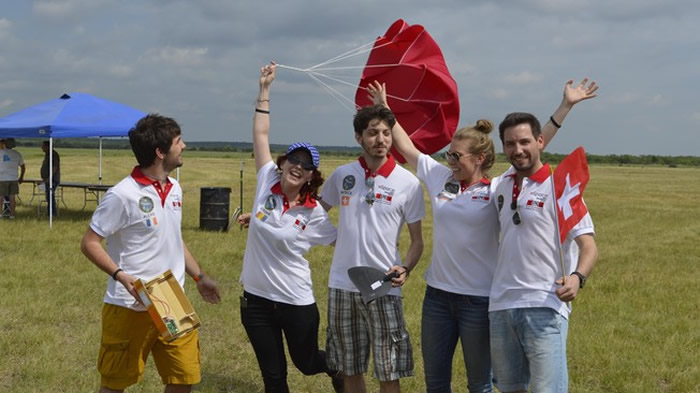EPFL team bottled it at the CanSat competition
In June, five EPFL students went to Texas for the competition final, where they put the device they had been working on all year to the test. How did they fare?
How do you get an entire spacecraft into a 3.5-liter container, which is the equivalent of a double-magnum wine bottle? For the first time, an EPFL team took up the challenge set each year by the CanSat competition, which has become one of the largest university events for space-related topics since it was started in the 1990s.
“We got the Tenderfoot Award, which goes to the best newcomer,” said Luca Barloggio, a Student in materials science. “We finished 20th out of 40 teams, as we didn’t have time to transmit all the data collected during the flight. But the wing design of our device was good, the telemetry worked well, and the container opened as planned.”
No more than 500 grams
It all started in a class given by Olivier de Weck, an Aeronautics and Astronautics Professor at MIT in Boston. The class is part of EPFL’s Minor in Spatial Technology, which the five students took together. One of their exercises was to work under the strict CanSat conditions. After the experiment, they all decided to give the real thing a go and applied for the competition.
Among the many requirements for the CanSat category selected by the EPFL team: the system must not weigh more than 500 grams; the materials used should not be at any risk of catching fire; the flight duration must be as close to two minutes as possible; and the cost cannot exceed $1,000. Released at an altitude of 600m, the vehicle has to sample the air pressure and temperature, take images and transmit the data to a ground station in real time.
A semester of work for two minutes of flight
Supported by experts from the Swiss Space Center and EPFL’s Laboratory of Intelligent Systems, the five students worked tirelessly on their project. “It seemed doable in theory, but when you actually have to develop the system, you realize what space science really is,” said Sorina Lupu, a Student in microengineering.
To design the CanSat, the group took inspiration from a tropical grain, “that glides to the ground when it falls from the tree,” said Barloggio. “The project taught us a lot. We learned how to work as a team, how to communicate with each other and with other people, how to organize our work, how to manage very diverse technical aspects and how to make the most of each person’s skills. And being part of a real project from start to finish has certainly made us better engineers!”
Motivated by the experience, the five students would like to take up the challenge again next year. They also hope that other EPFL students will follow in their footsteps and create more teams to compete.


Comments are closed, but trackbacks and pingbacks are open.